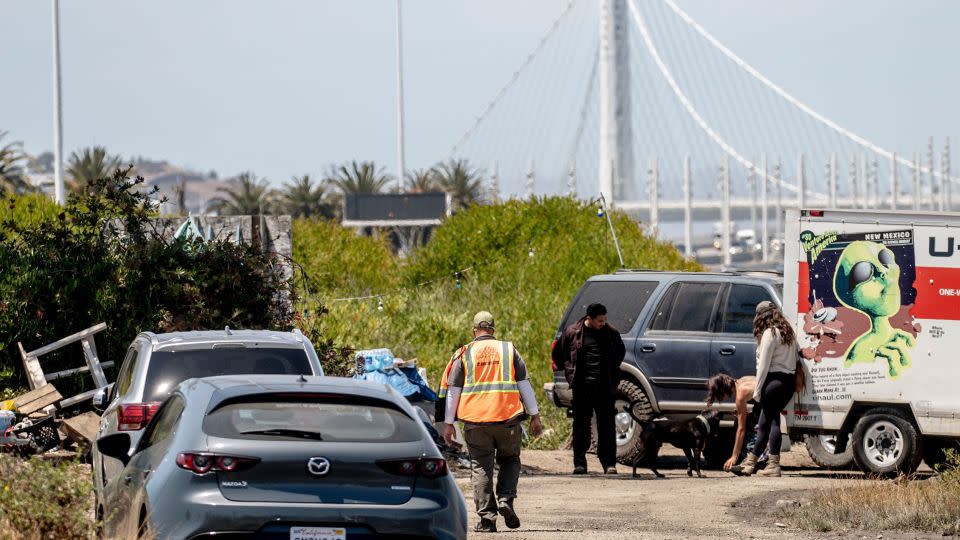Gov. Gavin Newsom issues executive order for removal of homeless encampments in California
- Oops!Something went wrong.Please try again later.
California Gov. Gavin Newsom, buoyed by a recent US Supreme Court decision, issued an executive order Thursday calling on state officials to begin taking down homeless encampments.
The move to begin dismantling thousands of encampments throughout California comes after the high court ruled last month in favor of an Oregon city that ticketed homeless people for sleeping outside. The ruling rejected arguments that such “anti-camping” ordinances violated the Constitution’s ban on “cruel and unusual” punishment.
“This executive order directs state agencies to move urgently to address dangerous encampments while supporting and assisting the individuals living in them — and provides guidance for cities and counties to do the same,” Newson said in a statement. “There are simply no more excuses. It’s time for everyone to do their part.”
The order calls on state officials “to adopt humane and dignified policies to urgently address encampments on state property.”
The move has drawn the ire of homeless advocates and elected officials.
“Newsom could have issued this order before the (Supreme Court) decision. The only difference now is that states and localities are free to confine and arrest people even when there is no shelter available,” said Chris Herring, an assistant professor of sociology at the University of California Los Angeles.
“So before the Supreme Court ruling cities were in the position where they would have to provide shelter offers before removing encampments. Now … they will be able to carry out these encampment sweeps with the very real threat of issuing people incredibly expensive fines of which people cannot pay and often results in a warrant or an arrest or can result in incarceration.”
Herring said the timing of the order wasn’t surprising as Newsom seeks to “politically clear his name of the homeless crisis, especially as he’s in the national spotlight right now amid the presidential election.”
In San Francisco, a spokesperson for Mayor London Breed said the city had already started to take action.

“Our city encampment teams and street outreach staff have been going out every day to bring people indoors, and to clean and clear encampments,” spokesperson Parisa Safarzadeh told CNN in a statement. “This is why we are seeing a five year low in the City’s tent count on our streets.”
Study shows cleanups do little to change numbers of homeless
Late last month, the results of the Los Angeles Homeless Services Authority’s point-in-time count – conducted in January – showed the homeless population in Los Angeles had dropped for the first time in six years. It showed overall homelessness and in particular unsheltered homelessness was down in both Los Angeles County and the city. According to the count, homelessness was down 2.2% in the Los Angeles and 0.27% in the county.
There were still 45,253 homeless people counted in the city and 75,312 people unhoused in the county, the authority reported.
“For the first time in years, unsheltered homelessness has decreased in Los Angeles because of a comprehensive approach that leads with housing and services, not criminalization,” Los Angeles Mayor Karen Bass said Thursday.
“Strategies that just move people along from one neighborhood to the next or give citations instead of housing do not work.”
In fact, a new study by the Rand Corp’s Center on Housing and Homelessness found encampment clearing efforts in Los Angeles had no long-term effect on the number of people on the streets.
The researchers looked at encampment cleanups in Venice, Hollywood and Skid Row in Los Angeles and “observed temporary declines in the unsheltered population that lasted two to three months on average” before returning to previous levels, according to the study.
In Venice, for instance, encampment removals meant “the share of unhoused people living literally unsheltered (e.g., without a tent) increased from 20 percent to 46 percent,” the study said.
Newsom last month praised the high court’s ruling, saying it “provides state and local officials the definitive authority to implement and enforce policies to clear unsafe encampments from our streets.”
“This decision removes the legal ambiguities that have tied the hands of local officials for years and limited their ability to deliver on common-sense measures to protect the safety and well-being of our communities,” Newsom added.
The case was the most significant appeal involving unhoused Americans to reach the Supreme Court in decades, and it was closely watched by cities and states across the nation wrestling with a sharp increase in homelessness.
LA County Supervisor Kathryn Barger said Newsom “rightfully points out that local government remains at the helm of homeless encampment removals.”
“Cities have an obligation to develop housing and shelter solutions in tandem with support services provided by County government,” Barger said in a statement. “This formula, which is largely based on partnerships, is how we can deliver permanent results. No single entity can achieve that.”
This story has been updated with additional information.
For more CNN news and newsletters create an account at CNN.com

